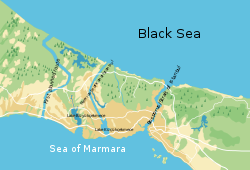Kanal Istanbul
| Kanal İstanbul | |
|---|---|
 |
|
| Specifications | |
| Length | 45–50 km (28–31 miles) |
| Locks | 0 |
| Status | First proposed in the 16th century; pre-feasibility studies commenced April 2009, announced April 2011, feasibility studies conducted April 2012, first stage of construction started April 2013 |
| Geography | |
| Start point | Black Sea |
| End point | Sea of Marmara |
Kanal İstanbul is the Turkish project name of the artificial sea-level waterway, which is being built by the Republic of Turkey on the European side of Turkey, connecting the Black Sea to the Sea of Marmara, and hence to the Aegean and Mediterranean Seas. Kanal İstanbul would bisect the current European side of Istanbul and thus form an island between the continents of Asia and Europe (the island would have a shoreline with the Black Sea, Sea of Marmara, the new canal and the Bosphorus). The new waterway would bypass the current Bosphorus. Kanal İstanbul aims to minimise shipping traffic in the Istanbul Strait. The project is intended for the 100th anniversary in 2023 of the foundation of the Turkish Republic.
The main purpose of the project is to reduce the marine traffic through the Bosphorus and minimize the risks and dangers associated particularly with tankers. About 56,000 vessels pass yearly through the Istanbul Strait, among them 10,000 tankers carrying 145 million tons of crude oil. International pressure is growing to increase the marine traffic tonnage through the Turkish straits that brings risks for the security of marine navigation during the passage. The canal will further help prevent the pollution caused by cargo vessels passing through or mooring in the Sea of Marmara before the southern entrance of the Bosphorus.
The waterway will have a length of 45–50 km (28–31 mi) with a depth of 25 m (82 ft). Its width will be 150 m (490 ft) on the surface and 120 m (390 ft) at the canal bed. These dimensions will allow the largest vessels and even submarines to pass.
The concept of a canal linking the Black Sea with the Sea of Marmara has been proposed at least seven times in history.
The first proposal was made by Ottoman sultan Suleiman the Magnificent (reigned 1520–1566). His architect Mimar Sinan was said to have devised plans for the project. The project was abandoned for unknown reasons.
...
Wikipedia
